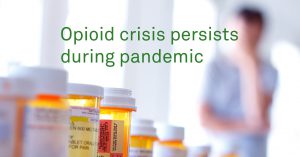Motor vehicle accidents rank as the second leading cause of unintentional deaths in the United States, according to the National Center for Injury Prevention and Control[1]. It’s no surprise that concerns about drugged driving have grown in the midst of our country’s opioid epidemic. While researchers historically studied alcohol fatalities and driving under the influence of alcohol, they have also shifted some of their focus to the impact of prescription opioids on drivers.
A study published in the Journal of the American Medical Association[2] showed that prescription
opioids are increasingly implicated as a contributing cause of fatal motor
vehicle accidents. Drivers involved in these deadly accidents were about twice
as likely to have taken prescription opiates as the non-initiators of crashes.
In this study, of the more than 1,400 drivers who tested
positive for prescription opioids, 31.7% tested positive for hydrocodone, 26.6%
for morphine, 18.5% for oxycodone, 14.3% for methadone, and 8.9% for other
opioids. The research also points to a heightened risk for drivers under the
age of 35 years old and older than 65.
Data showed that the most common driver error is veering out
of their lane (41%), followed by failure to yield the right of way (25%), and
speeding (17%). The inability of a
driver to stay in their lane was the key factor in 4 out of 10 deadly accidents
studied. The findings resulted from the analysis of more than 18,000 fatal 2-car
accidents from 1993 to 2016.
Opioids, like alcohol, can cause drowsiness and dizziness; reducing
reaction times and slowing the motor skills required for safe driving. It’s
important to understand the risks of using these medications and the potential impacts
they have on an individual’s ability to operate a vehicle.
For more information about drug testing, visit our website.
[1] National
Center for Injury Prevention and Control. 10 Leading Causes of Injury
Deaths by Age Group Highlighting Unintentional Injury Deaths, United
States–2015. Atlanta, GA: Centers
for Disease Control and Prevention; 2016.
[2] Chihuri S, Li G. Use of prescription opioids and initiation of fatal 2-vehicle crashes. JAMA Netw Open. 2019;2(2):e188081. doi:10.1001/jamanetworkopen.2018.8081
Photo courtesy of Dmitry-Kalinovsky/Shutterstock
 Your Privacy Choices
|
Privacy Notices
|
Terms
|
Language Assistance / Non-Discrimination Notice | Asistencia de Idiomas / Aviso de no Discriminación | 語言協助 / 不䈚視通知
Your Privacy Choices
|
Privacy Notices
|
Terms
|
Language Assistance / Non-Discrimination Notice | Asistencia de Idiomas / Aviso de no Discriminación | 語言協助 / 不䈚視通知


















Motor vehicle accidents rank as the second leading cause of unintentional deaths in the United States, according to the National Center for Injury Prevention and Control[1]. It’s no surprise that concerns about drugged driving have grown in the midst of our country’s opioid epidemic. While researchers historically studied alcohol fatalities and driving under the influence of alcohol, they have also shifted some of their focus to the impact of prescription opioids on drivers.
A study published in the Journal of the American Medical Association[2] showed that prescription opioids are increasingly implicated as a contributing cause of fatal motor vehicle accidents. Drivers involved in these deadly accidents were about twice as likely to have taken prescription opiates as the non-initiators of crashes.
In this study, of the more than 1,400 drivers who tested positive for prescription opioids, 31.7% tested positive for hydrocodone, 26.6% for morphine, 18.5% for oxycodone, 14.3% for methadone, and 8.9% for other opioids. The research also points to a heightened risk for drivers under the age of 35 years old and older than 65.
Data showed that the most common driver error is veering out of their lane (41%), followed by failure to yield the right of way (25%), and speeding (17%). The inability of a driver to stay in their lane was the key factor in 4 out of 10 deadly accidents studied. The findings resulted from the analysis of more than 18,000 fatal 2-car accidents from 1993 to 2016.
Opioids, like alcohol, can cause drowsiness and dizziness; reducing reaction times and slowing the motor skills required for safe driving. It’s important to understand the risks of using these medications and the potential impacts they have on an individual’s ability to operate a vehicle.
For more information about drug testing, visit our website.
[1] National Center for Injury Prevention and Control. 10 Leading Causes of Injury Deaths by Age Group Highlighting Unintentional Injury Deaths, United States–2015. Atlanta, GA: Centers for Disease Control and Prevention; 2016.
[2] Chihuri S, Li G. Use of prescription opioids and initiation of fatal 2-vehicle crashes. JAMA Netw Open. 2019;2(2):e188081. doi:10.1001/jamanetworkopen.2018.8081
Photo courtesy of Dmitry-Kalinovsky/Shutterstock